From pv magazine USA
The global energy storage market is expected to enter a “prolonged period of growth” this year, with annual installations reaching more than 30 GW by 2030, up 250% from 2021 levels. That’s according to a new report from IHS Markit.
The firm forecasts that the energy storage industry will notch rapid growth this year, with installations topping 12 GW. That would be an increase of more than 7 GW from 2020. Annual global installations are forecast to exceed 20 GW in 2024 and 30 GW by 2030.
The company said its outlook is underpinned by a growing number of national energy storage targets linked to stronger decarbonization goals. It said of particular note was China’s recently announced 30 GW energy storage target by 2025, which will help Asia to account for a growing share of global demand in the coming five years.
Supply constraints
IHS Markit said growth in electric vehicle (EV) adoption is leading to increased constraints in the supply of Li-ion batteries. This could cause delays to project commissioning as cell manufacturers prioritize larger customers in the automotive industry over relatively small energy storage system integrators.
The lower share of battery demand from the energy storage industry will leave it at risk of supply shortages. Even so, IHS Markit said it expects that the disruption to ease within 12-18 months, as suppliers diversify their supply base and EV manufacturers firm their procurement plans.
Globally, around 87 GW of national energy storage targets have been announced this year. Reaching those goals will require developing new market opportunities as well as regulatory changes, IHS Markit said.
It said this is particularly the case in China, where targets are expected to drive it to be the largest market globally in terms of annual installations by 2025. The firm said China will grow “significantly faster” than any other region in order to meet its target, with annual installation levels expected to be 14 times higher than 2020 levels in 2030. This compares to growth rates of 3 times and 4 times for the United States and Europe, respectively.
This content is protected by copyright and may not be reused. If you want to cooperate with us and would like to reuse some of our content, please contact: editors@pv-magazine.com.









By submitting this form you agree to pv magazine using your data for the purposes of publishing your comment.
Your personal data will only be disclosed or otherwise transmitted to third parties for the purposes of spam filtering or if this is necessary for technical maintenance of the website. Any other transfer to third parties will not take place unless this is justified on the basis of applicable data protection regulations or if pv magazine is legally obliged to do so.
You may revoke this consent at any time with effect for the future, in which case your personal data will be deleted immediately. Otherwise, your data will be deleted if pv magazine has processed your request or the purpose of data storage is fulfilled.
Further information on data privacy can be found in our Data Protection Policy.